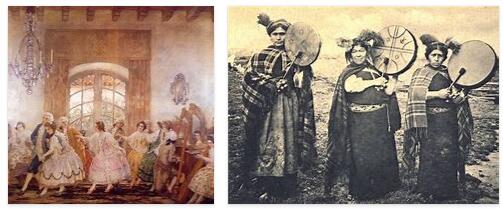History of Chile up to the Spanish conquest
The first inhabitants and indigenous peoples of Chile
From 12,000 BC There is evidence that people lived in what is now Chile. They were hunters and gatherers. Cultures like the Chinchorro emerged in the hot north. They mummified their dead and were the first to do so (7000-1500 BC). From around 2000 BC Agriculture and animal husbandry emerged. The Atacameños settled in the oases of the Atacama Desert. They built a fortress, the Pukará de Quitor castle, the ruins of which can be visited.
Around 600 AD, peoples from Polynesia settled Easter Island, which is now part of Chile. Indigenous peoples lived all over Chile. In the north, the Chango inhabited the coast and the Aymara in the east. From 850 the Diaguita settled south of them. They all grew beans, corn, and quinoa, and kept llamas and alpacas. The Mapuche lived in the center and south. Chonos lived in the south, further south on Tierra del Fuego the Kawesqar and the Yagan lived. They mainly engaged in fishing.
Inca
The north of Chile was conquered by the Inca in the 15th century. The Mapuche prevented the Inca from advancing south.
The first conquistador: Diego de Almagro (1535)
After Christopher Columbus discovered America, more and more Spaniards and other Europeans came to South America. They conquered the country by force. In 1535 Diego de Almagro came to Chile from Peru. He looked for gold, but could hardly find it. His men were stopped by the Mapuche while advancing south. So Almagro returned to Peru.
Pedro de Valdivia (1540/1541)
In 1540 the second attempt to take Chile took place. Pedro de Valdivia also aroused resistance from the Mapuche, but nonetheless established the first settlements. Today’s capital Santiago as well as La Serena and Valparaíso were founded during this time. But the Mapuche did not give up. The Spaniards were able to capture seven caciks (leaders of the Indians) with an ambush. In September 1541 the Mapuche attacked Santiago. They had drawn thousands of their men together in the woods.
What did Inés de Suárez do?
When the Mapuche attacked, a woman turned the tide in favor of the Spaniards and raged particularly cruelly: Inés de Suárez was Valdivia’s lover. She suggested that the heads of the seven caciques be chopped off and began with the first herself. The heads were thrown under the attacking Mapuche. Inés mounted a white horse and rode first towards the Mapuche. The Mapuche fled in panic.
Spanish colony – but without the south
In 1542 the Spaniards founded the Viceroyalty of Peru, which initially comprised almost all of South America. Today’s Chile was one of them. In northern Chile, the Spaniards forced the Indians to work for them on their plantations. For centuries, however, the south remained under the control of the Mapuche, who continued to fiercely oppose the capture of their land. In 1553 they killed Pedro de Valdivia.
Again and again there were heavy fights. The cities founded by the Spaniards south of the Bío-Bío river were all destroyed again. It was not until 1881 that Chilean troops were able to defeat the Mapuche. Other obstacles to the colonization of Chile were raids by English pirates on the coast, as well as severe earthquakes, such as in 1647 when 12,000 people were killed in Santiago.
Robinson Crusoe
Do you know the story of Robinson Crusoe, who was shipwrecked and lived on a desert island for many years? The model for this story by the writer Daniel Defoe was a Scottish seafarer who landed in 1704 on an island that belongs to the Chilean Juan Fernández Islands. He spent four years there. This island was even renamed Robinson Crusoe Island in 1970.
From independence to the 1960s
Independence
In 1810 Chile declared its independence from Spain, but the decisive victory was not achieved until 1818. The leaders in the Chilean War of Independence were José Miguel Carrera, Bernardo O’Higgins and, from Argentina, finally José de San Martín. Ultimately, the battle of Maipú on April 5, 1818 was decisive. To get more information on Chile and South America, check intershippingrates.
The Republic
O’Higgins became the first president of Chile, but had to resign in 1823. The big landowners and conservatives prevailed against the liberals in 1833 and established an authoritarian republic. That is, they alone determined.
The economy flourished mainly thanks to saltpetre. In 1879 Chile began to mine saltpetre in areas that did not belong to its own national territory. War broke out with Peru and Bolivia. Chile won this “saltpeter war” and Bolivia lost its access to the sea.
In 1891 the military and parliament rose against President Balmaceda and Chile received a new constitution. The period between 1891 and 1925 is known as the “parliamentary republic “.
Immigrant
Many Europeans immigrated to Chile as early as the 18th century and increasingly in the 19th to the beginning of the 20th century. Mainly Spaniards came to Chile, and here again the majority of the Basques, i.e. people from northeastern Spain.
But Germans, Austrians, English, French, Greeks and Italians also came to the country and became the ancestors of today’s Chileans. The state offered the immigrants cheap land to settle in Chile.
